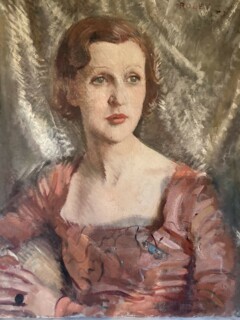A Portrait of the Journalist as a Young Woman
Amanda Baillieu
After my mother died last year my sister and I sold almost all the paintings, drawings and prints that she and my stepfather, an art dealer, had amassed over fifty years. One of the eight hundred items loaded onto a van was a youthful portrait of my grandmother, the writer and journalist Mollie Panter-Downes.
A few months later I was sent a draft of the auctioneer’s catalogue. The portrait had a reserve of £300 and the artist had been identified as Eileen Robey, the daughter of Sir George Robey, one of the great music hall performers. The women were born a few years apart, Eileen in 1902 and Mollie in 1906.
Eileen Robey is a shadowy figure despite her obvious talent as a painter. Portraits by her occasionally surface at auctions but she is not represented in any of the national galleries and my attempts to research her career were unsuccessful. The auction house catalogue meanwhile described Mollie as a writer, ‘largely forgotten today’. If the portrait were sold to a private buyer, I thought, wouldn’t I be helping to deepen her obscurity? I also felt a sense of injustice. If it had been a portrait of a male writer by a male artist, would the description have been so dismissive and the price so low? I withdrew the painting from the sale.
Mollie Panter-Downes was an emotionally distant grandmother. Her father, a colonel in the Royal Irish Regiment, had been killed at Mons in 1914. After his death his widow and daughter moved from one cheap hotel to the next, or took lodgings, but always striving to keep up appearances.
Despite having no formal education, Mollie at the age of sixteen wrote a bestselling romantic novel, The Shoreless Sea. The Daily Mirror bought serial rights and ads appeared on London buses. The book went through eight editions in eighteen months. She was able to rent a flat in Knightsbridge, hire furniture from Harrods and take on an agent.
As children, we knew Mollie was a bestselling novelist but none of us had read The Shoreless Sea because she refused to have a copy in the house. She wrote three more novels between 1925 and 1931 but later disowned them and only returned to novel writing once, in 1947, with One Fine Day, an account of a day in the life of a middle-class woman after the war.
Sorting through Mollie’s papers I found a scrapbook, compiled by her mother, of reviews of The Shoreless Sea. Every newspaper cutting from the Dundee Courier to the Times had been carefully saved, along with a congratulatory letter from Buckingham Palace asking if the queen could buy three signed copies.
I also found countless folders of correspondence with the New Yorker, which she wrote for throughout the Second World War. Her short stories had already been published by the magazine but in July 1939 – against her agent’s advice – she wrote a piece about a Kindertransport arriving at Liverpool Street Station. Two months later she received a Western Union cable inviting her to write a regular ‘Letter from London’. Her dispatches appeared in the magazine every week or two during the war – the first of them on 3 September 1939, the day Britain declared war on Germany – and she continued to contribute until the early 1980s.
The cables reveal the way she worked. She would make weekly visits to London and jot down her observations in a little lined notebook, then take the train home to write it up in a hut in her garden in Surrey. A few days later her typed copy would be taken to Haslemere station and handed to the guard, who would carry it to the Western Union office at Waterloo where it would be cabled to New York. Among the hundreds of letters in her archive is one from the Ministry of Information praising her journalism for its contribution to the war effort.
She was modest to the end: ‘I’m a reporter,’ she said, ‘I can’t invent.’ But despite all she did to explain life in wartime England to American readers, she never won a prize or any official acknowledgment from the British government. When Eileen Robey’s painting of her came back from the auction house we offered it to the National Portrait Gallery. It is now in their collection and available to view online.

Comments
I recently read your grandmother's book One Fine Day, after hearing about it on an episode of the podcast Backlisted.
I read it in almost one sitting. Mollie Panter-Downes writes so beautifully and visually. I lent it to a friend after, who also got a lot of pleasure from it.
Your grandmother continues to be read and enjoyed. I hope that brings you comfort.
Thank you for sharing her portrait which quite rightly deserves to be on display for the general public.